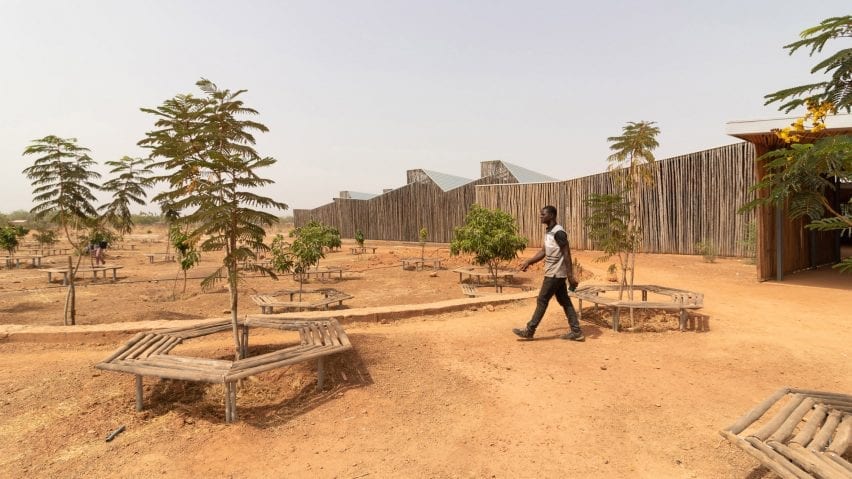Burkinabe architect Diébédo Francis Kéré's studio has built a university in Burkina Faso, western Africa, which has walls made with locally sourced clay and screens of eucalyptus wood.
The facility, named the Burkina Institute of Technology, forms part of Lycée Schorge Secondary School campus in Koudougou that was also designed by Kéré Architecture.
It was built to expand the campus, owned by the Stern Stewart Institute, and offer high school graduates an opportunity to continue their education.
The 2,100-square-metre building is composed of a series of repeated modules that contain classrooms, lecture halls and auxiliary spaces.
The modules are placed in a staggered formation to facilitate airflow in and around the building. Those that contain the classrooms are arranged around a rectangular courtyard at their centre.
Each module of the Burkina Institute of Technology is made with local clay that has been combined with concrete and then poured and cast in-situ into large formworks.
The formworks are the size of one whole classroom and were designed to be disassembled and rebuilt to cast each module.
This building technique is informed by the studio's construction of a primary school in Gando, for which it has used the same method. It is a quicker and more flexible construction method than using traditional clay bricks.
Clay was also chosen as it is locally abundant and helps to cool the institute's interiors through thermal mass.
The cooling properties of the clay work in tandem with mechanical air conditioning, and openings in the walls and a saw-tooth roof profile.
The rooftop openings are designed to release warm air through the stack effect – a technique that naturally ventilates buildings by expelling rising hot air.
Around each classroom are shaded corridors and walkways, framed by screens of locally sourced eucalyptus wood. These screens unify the institute with the Lycée Schorge Secondary School, which is lined with the same wood.
Eucalyptus wood has also been used inside to cover the hanging ceilings inside the classrooms, adding visual warmth to the interiors and complementing the clay walls.
The building is complete with an extensive landscape design that has been planned to protect the university during the rainy season, as the site is located on a flood plain.
It works by channelling water into a large underground tank that is then stored and available for irrigating mango plantations on the campus.
Kéré Architecture was founded by Kéré in Berlin in 2005. Other recent projects by the studio include the Tippet Rise Art Center pavilion in Montana, USA, which was crafted from dead trees.
It is currently also developing Benin's parliament, which is modelled on the African palaver tree.
The photography is by Jaime Herraiz for Kéré Architecture.
Project credits:
Architect: Kéré Architecture, Diébédo Francis Kéré
Design ream: Jaime Herraiz Martínez, Andrea Maretto
Contributors: Juan Carlos Zapata, Valentin Billhardt
Construction supervision: Diébédo Francis Kéré, Nataniel Sawadogo, Jaime Herraiz Martínez
Landscape design: Kéré Architecture
Client: Stern Stewart Institute

